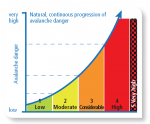In 1993, the European Avalanche Warning Services agreed to introduce a uniform avalanche danger scale. The common scale defines the danger level based on the likelihood and size of avalanches. The complete description of the scale also contains additional, not internationally agreed columns on typical characteristics, recommendations and effects.
The avalanche danger levels – a simplified representation of the complex processes in nature.
The European Avalanche Danger Scale is a five-level, ordinarily ascending, categorical scale. Ordinary ascending means that the scale has a ordinary ascending ranking. Categorical means that the scale consists of classes which – even if they are expressed with the numbers 1-5 – may not simply be processed mathematically. For example, the danger level 3-Considerable is not simply higher by one than danger level 2-Moderate, because the avalanche danger probably increases disproportionately (i.e. not linearly). In other words, danger level 3-Considerable is not one level higher than 2-Moderate, but probably twice as high. The danger levels must not be added either.
Definitions in the European avalanche danger scale
In the definition of the danger scale, the characteristics of the avalanche danger are defined for each level with the parameters
- snowpack stability,
- its spatial distribution and
- avalanche size.
The changes or the combination of these input variables determine the avalanche danger level. Avalanche forecasters in Europe have agreed to use the EAWS matrix for a more harmonised determination of the danger levels. In order to do so, they take the three parameters snowpack stability, its spatial distribution and avalanche size into account. In the case of 1-Low avalanche danger, for example, small avalanches should only be triggered in a few places and usually only with a high additional load, whereas in the case of avalanche danger 4-High many and sometimes also very large avalanches are likely to be triggered with to low additional loads (e.g. skiers) or may release spontaneously. The European avalanche danger level scale consists of five levels. In nature, however, the avalanche danger changes continuously and rises disproportionately.
